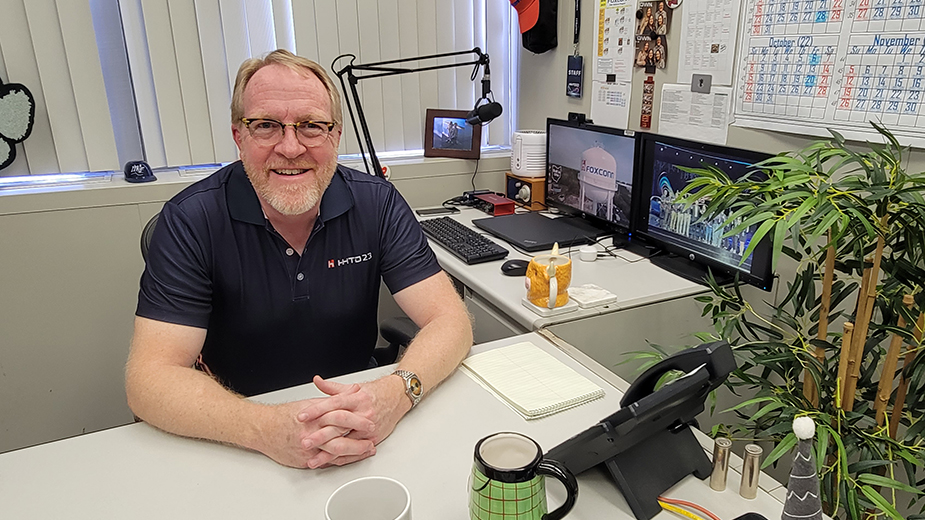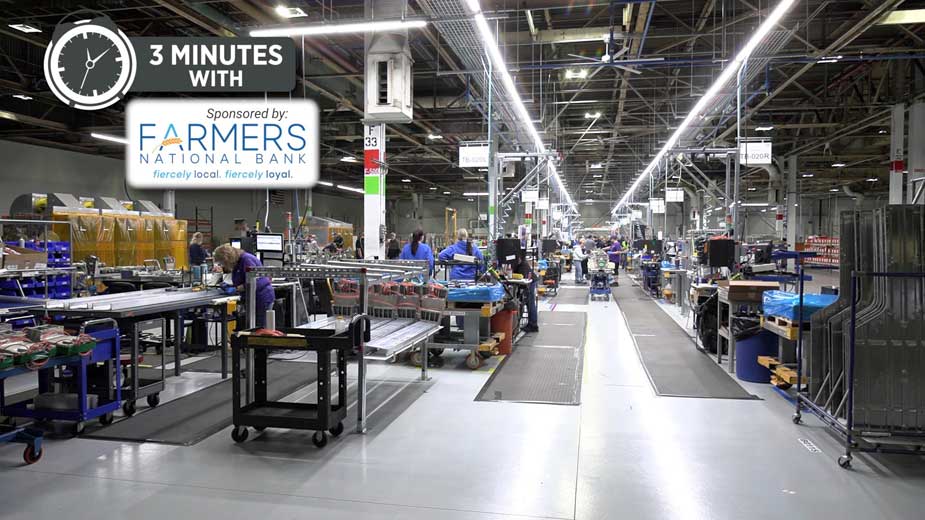Foxconn Vets Inquiries for Space at Lordstown Plant
LORDSTOWN, Ohio – The conversation begins with some form of outreach.
Perhaps it’s an engineer or executive touching base through social media, a phone call, an email, or text message. Or it could be a chance meeting at a trade expo or some other function.
Those in business development and operations at Foxconn Ohio field plenty of these inquiries. As the largest consumer electronics contract manufacturer in the world, Taiwan-based Foxconn is on the radar screens of hundreds of worldwide companies that would like to partner with the tech giant.
“Foxconn is established and reputable around the world,” says Michael Repetto, senior director of project management at Foxconn Ohio’s Lordstown plant. “A lot of people are knocking on our door.”
But gaining entry and formulating a partnership is another matter entirely, Repetto says.
Potential customers are put through a dedicated vetting process that dives deep into their business that, in the end, will determine whether that company is the right fit for Foxconn.
“Right now, we’re dealing with 15 to 20 different companies,” Repetto says. “From startups to mid-size OEMs (original equipment manufacturers) that want to localize here in the U.S.”
Foxconn’s ultimate goal is to establish manufacturing relationships with a diverse base of customers across the electric-vehicle space.
Should these clients match up with Foxconn’s objectives, Foxconn would love nothing better than to begin production of a dynamic set of EV products that could someday fill the giant Lordstown factory it acquired in 2022, Repetto says.
Being Selective
However, Foxconn needs to be selective as to which partners complement the company’s leadership philosophy, workforce, business strategy and product vision. And that takes time.

“We don’t want to allocate floor space, invest a lot of money in capital equipment and human resources, and find out they’re just going to be sitting there,” Repetto says.
Instead, it’s Foxconn’s obligation and responsibility to closely evaluate every opportunity, idea and potential product, he says.
“With every engagement that we have, we all ask the same questions. ‘Would you buy the product yourself? Is it something that makes sense? Is it a product that’s functional? Is it differentiated from the market? Can you see that it would sell?’” Repetto says.
But these are just among the first set of initial questions to hurdle as Foxconn moves forward with its plans to transform the former General Motors Lordstown complex into a powerhouse manufacturer of electric vehicles of all kinds, Repetto says.
“Then you start to meet your customer, the person with the idea,” he says. “Then you go from there.”
Repetto acknowledges that most of the companies that Foxconn deals with are startups, those that do not have the deep pockets to purchase, equip or maintain a large assembly or production factory.
“They’re coming to us for a reason,” he says. “They don’t have billions of dollars to spend on a big plant. They need to spend money on what makes sense. We can help them build the product.”
The vetting process begins with an initial engagement. After that comes an evaluation on whether the venture merits a nondisclosure agreement, so both parties could begin more detailed discussions. “We have to believe in the product,” Repetto says.
The second step is to determine the nature, engineering and size of the vehicle the customer wants to produce and whether the concept or product would work and sell in the market, he says. Also, the client needs to be specific on Foxconn’s role in developing and producing the vehicle.
In some cases, for example, a client might want Foxconn to take on a broader role in supply chain management, Repetto says.
Once these issues are addressed, then Foxconn would prepare a quote on the estimated costs required to produce the vehicle.
Business Alignment
Aligning a potential partner’s leadership with Foxconn is also critical. “At some point, we have to look each other in the eye and talk about real numbers,” Repetto says.
These include production costs, and potential investment from Foxconn in terms of workforce, equipment and plant floor space. “We need to have a real-life discussion about how we handle that,” he says.
Funding is also critical, and there needs to be some assurance that the potential partner is spending its money wisely and has the financial resources to move forward.
“We don’t want to sign up with companies that have planes that fly all over the world,” Repetto says. “We’re trying to align with businesspeople that have good vision and spend money properly. The alignment of leadership is absolutely key.”
Should Foxconn and a client come to basic terms, the parties would develop and sign a memorandum of understanding that signals they would work toward a final deal. Once many of these details are addressed, then the partnership moves to a fourth stage – a contract manufacturing agreement, Repetto says.
“Stage five means we’re in production,” he says.
Market Positioning
Product selection is also critical to build business at the Lordstown plant, says Rick Rajaie, vice president of operations for Foxconn EV North America.
“In any business, you have to have product differentiation,” he says. “One thing I made clear to our management when I got here is that we don’t want to go blindly after Tesla,” he says. “Whoever says that they’re going to beat Tesla – there’s no reality behind their business.”
Instead, it’s Rajaie’s strategy to compete in higher margin EV markets where Foxconn stands out.
A perfect example is Monarch Tractor, a California-based company that designs and produces an all-electric, driverless-optional tractor, he says. Last year, Foxconn and Monarch announced they would begin building the tractor – the MK-V – at the Lordstown plant. The first EVs rolled out of the plant in April.
“In early 2021, when I was in Taiwan, I came up with the idea of making tractors,” Rajaie says, noting he’d already made connections with the leadership at Monarch.
Monarch tractors are now being manufactured and shipped from the plant, setting the tone for future business development in Lordstown.
“We are separating ourselves from the majority of the crowd that want to be in the mainstream and want to compete over very marginal profit,” Rajaie says. “We would like to be in a different market.”
Rajaie says Foxconn is working with a variety of partners that are not associated with the mainstream EV market. “Semi trucks, delivery vans, excavation companies,” he says.
While these electric vehicles likely command lower volumes than mass-market passenger EVs, Rajaie believes revenue generation would be sufficient for long-term adoption and business growth.
“We’re not going to brand ourselves and copy and paste another carmaker,” Rajaie says. “That’s not our vision. That’s not our goal.”
Still, Foxconn moves deliberately and methodically through the due diligence process, Rajaie says. Some companies that approach Foxconn aren’t necessarily EV manufacturers but are nevertheless associated with the EV market. Foxconn treats each opportunity on a case-by-case basis.
Challenges, Opportunities
Ian Upton, assistant plant manager and director of production control at Foxconn Ohio, says the company’s drive to manufacture an eclectic mix of EVs from a single plant poses both challenges and opportunities.

“It definitely adds complexity to materials scheduling, material flow, and the build process,” he says.
That’s because each EV product that is manufactured from Lordstown would be substantially different from the other, requiring different tooling, manufacturing processes and components.
A Monarch MK-V, for example, could not be built on the same line as a delivery van. “There are too many differences,” he says.
Yet Foxconn’s operation is much different than the traditional assembly line that the plant was accustomed to for more than 50 years under GM, says Upton, who once worked at GM Lordstown.
Often, when GM assigned multiple vehicles to a plant, these were vehicles that were built from the same platform, such as the Chevrolet Cavalier and the Pontiac Sunfire, which were simultaneously produced at the Lordstown plant on the same J-car platform.
Foxconn’s build model changes the game completely, Upton says. “We are designing our process with as much flexibility as we can,” he says, so Foxconn could provide the best value proposition to a customer. “It’s a capital-light way for someone to get into the market,” he says.
Selecting Lordstown as the site to launch this segment of the business made sense, Rajaie says.
Initially, Foxconn considered building a new complex in Wisconsin, he says.
However, that plant would have taken more than four years to complete and place into commission. Instead, Foxconn opted to acquire the Lordstown factory in May 2022 when the opportunity presented itself.
Another reason Foxconn selected Lordstown is its location, Rajaie says. Its position near major highway arteries provides access to markets that accommodate both import and export activities. And, the vice president adds the region boasts a healthy workforce that is steeped in manufacturing.
“We have ready people – 400 to 500 with skills to build EVs. It’s the biggest asset we have here,” he says.
Moreover, Rajaie says the company is committed to building an entirely new EV culture and business strategy across the Mahoning Valley.
“We are serious,” Rajaie says. “It’s not necessarily about winning or money. It’s about diversifying our portfolio within electrification from end-to-end.”
“We have to bring new business here,” he says, noting that Foxconn is poised to make further announcements on additional products for the plant once it completes its due diligence.
“The objective is clear,” Rajai says. “Additional business, hiring people, train our people, and just grow.”
Pictured at top: Employees assemble battery packs for Monarch Tractor’s MK-V at Foxconn’s Lordstown plant.
To read more about Foxconn, visit The Business Journal’s Inside Foxconn Ohio page.
Copyright 2024 The Business Journal, Youngstown, Ohio.



